Essential modifications to the
Vacuum Braking System
This
Feldbahn was ordered with a vacuum braking system, including the vacuum
limiting valve, as part of the factory build so I expected it to work
equally as well as the system that had been installed on the Stafford
which I owned
previously. Although the vacuum brakes were being used on the
Feldbahn's first run the ejector was somewhat ignored as all the
drivers who had a go were preoccupied with trying to
maintain enough steam pressure to keep the Feldbahn moving.
No matter what we
did, or how much steam blower we used, it was impossible to get the
boiler pressure about 85 psi. Having owned the
Stafford for
four years and having driven it almost 700 miles the Feldbahn's
performance was a real disappointment and so much steam blower was
being
used to maintain the 85 psi that the consumption of coal and water was
almost double that of the Stafford. The second run started
out in
the same fashion until I tried running without the vacuum brake system
operating. Instantly the Feldbahn came alive and the boiler
pressure easily stabilised at almost 120 psi, in fact once on the move
no steam blower was required and the firebox door had to be kept
slightly open to stop the safety valve constantly blowing off.
After trying it for themselves several different drivers all
came
to the same conclusion as I had; the vacuum braking system was
pressurising the smokebox and preventing the boiler from steaming
properly. I already knew that the ejector exhausted its steam
directly through a gland in the side of the smokebox which was
identical to the system that had worked so well on the Stafford, so why
was this engine performing so differently ? Obviously I was
going
to have to experiment to overcome the problem.
|
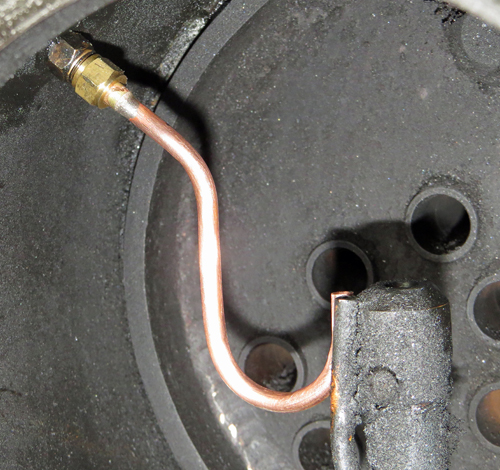 The
first experiment was to direct the ejector exhaust up the funnel.
In this photo you can see where the ejector exhaust entered
the
smokebox via the dirty gland nut at the top left corner of the photo.
As supplied there was nothing attached to this gland so the
exhaust steam just rushed into the smokebox (which was exactly the same
as it had been on the Stafford). I tried running the Feldbahn
with the ejector exhaust steam fed through the new pipe shown in the
photo,
but not surprisingly it operated exactly the same as the steam blower
did and the fire was now uncontrollable. After a couple of
laps
of the Pinewood track with the safety valve blowing constantly despite
the steam blower being turned off this experiment was deemed a failure. The
first experiment was to direct the ejector exhaust up the funnel.
In this photo you can see where the ejector exhaust entered
the
smokebox via the dirty gland nut at the top left corner of the photo.
As supplied there was nothing attached to this gland so the
exhaust steam just rushed into the smokebox (which was exactly the same
as it had been on the Stafford). I tried running the Feldbahn
with the ejector exhaust steam fed through the new pipe shown in the
photo,
but not surprisingly it operated exactly the same as the steam blower
did and the fire was now uncontrollable. After a couple of
laps
of the Pinewood track with the safety valve blowing constantly despite
the steam blower being turned off this experiment was deemed a failure.
|
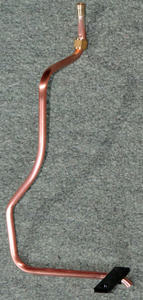 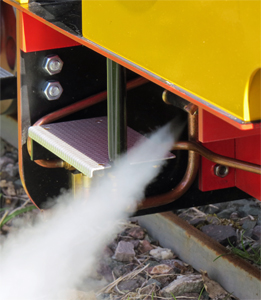 The
next experiment was to simply dump the ejector exhaust steam directly
into the open air, so for this the pipe shown on the left was used to
take the exhaust underneath the footplate. The black painted
bar
at the bottom of the photo held the pipe firmly in place as it was
retained by one of the existing cab side bolts. This
configuration made a significant improvement as the Feldbahn now
steamed happily, and when compared to operating without the
vacuum
braking system in use only a small amount of additional steam blower
was required to maintain the boiler pressure at 120 psi when running
with the vacuum brakes operating. The possible downside to
this
configuration was that a constant plume of steam was being noisly
discharged
from under the footplate as shown in the photo. The
next experiment was to simply dump the ejector exhaust steam directly
into the open air, so for this the pipe shown on the left was used to
take the exhaust underneath the footplate. The black painted
bar
at the bottom of the photo held the pipe firmly in place as it was
retained by one of the existing cab side bolts. This
configuration made a significant improvement as the Feldbahn now
steamed happily, and when compared to operating without the
vacuum
braking system in use only a small amount of additional steam blower
was required to maintain the boiler pressure at 120 psi when running
with the vacuum brakes operating. The possible downside to
this
configuration was that a constant plume of steam was being noisly
discharged
from under the footplate as shown in the photo.
The
experiments had already shown that to maintain a vacuum of 15 in Hg the
ejector required quite a lot of steam with the standard control valve
having to be opened about 1/8 to 1/4 of a turn. In contrast
the
ejector fitted to the Stafford had required much less steam, and
because the steam valve had to be opened so little (it was almost
impossible to adjust it for the minimum amount of
steam required)
I had actually fitted a fine control needle valve to the Stafford.
So far as I could tell the ejector fitted to the Feldbahn was
using far more steam than that supplied with the Stafford, and
presumably that was why it pressurised the smokebox and so severely
limited the ability of the boiler to raise steam.
This was
as far as my experiments progressed in 2014. I knew what was
wrong with the vacuum braking system supplied by Station Road Steam but
despite talking with them neither of us knew why it was so different to
that which had operated faultlessly on the Stafford. |
|
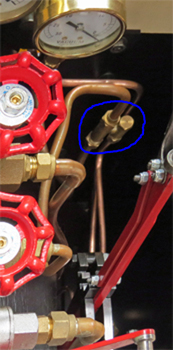 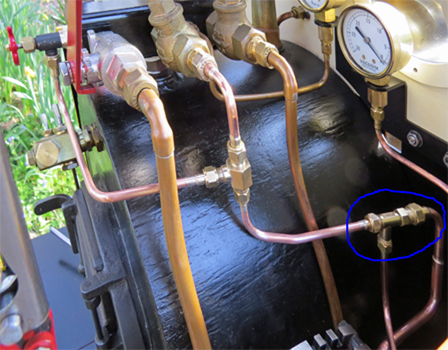 For
the 2015 running season something had to be done. So far as I
could tell the problem was being caused by the ejector apparently
requiring far more steam to operate than the ejector fitted to the
Stafford had required. PNP Railways manufacture an ejector
which
they claim has "a low steam consumption" and can operate at boiler
pressures up to 120 psi so I decided to purchase one and see how that
worked. The photo on the left shows the Feldbahn vacuum brake
ejector system as supplied by Station Road Steam. The ejector
(ringed in blue) is designed to work in the vertical plane so all the
pipes connecting to it run either straight up or down. The
problem with the PNP ejector was that it required the vacuum
pipe
section (containing the non return valve) to be vertical but the other
connections are then in the horizontal plane. You can see
this in
the photo on the right where the ejector is again ringed in blue. For
the 2015 running season something had to be done. So far as I
could tell the problem was being caused by the ejector apparently
requiring far more steam to operate than the ejector fitted to the
Stafford had required. PNP Railways manufacture an ejector
which
they claim has "a low steam consumption" and can operate at boiler
pressures up to 120 psi so I decided to purchase one and see how that
worked. The photo on the left shows the Feldbahn vacuum brake
ejector system as supplied by Station Road Steam. The ejector
(ringed in blue) is designed to work in the vertical plane so all the
pipes connecting to it run either straight up or down. The
problem with the PNP ejector was that it required the vacuum
pipe
section (containing the non return valve) to be vertical but the other
connections are then in the horizontal plane. You can see
this in
the photo on the right where the ejector is again ringed in blue.
The
installation of this ejector required a lot of new pipes to be made,
and as it was supposed to use less steam I decided to fit a small steam
valve to give finer control of the steam supply to the ejector in the
same way as I had on the Stafford. Thankfully the steam
manifold
already had a spare port in it's end above the firebox door so the
needle
valve was fitted there and plumbed into the ejector steam pipe using a
"T" piece connector.
On test this PNP ejector was found to
use less steam than the original Station Road Steam item, which wasn't
surprising as inspection had shown that the hole in its steam cone was
just under half the diameter of the original one. Currently
the
large (original) steam valve is only used to create the initial vacuum
in the train pipe and coaching stock. Once the required 15 in
Hg
is achieved the large steam valve is completely closed and the needle
valve is opened about 3/16 to 1/2 a turn depending on how much the
coaching stocks vacuum system leaks. This still gives quite a
cloud of steam under the footplate but at least the sound of escaping
steam is much less than it had been. The obvious question is,
could the ejector exhaust now be put back into the smokebox ?
Sadly at the moment I can't be bothered to find out as I'm
busy
with other projects but if I do ever get around to further experiments
then this page will relate what happens. |
|





